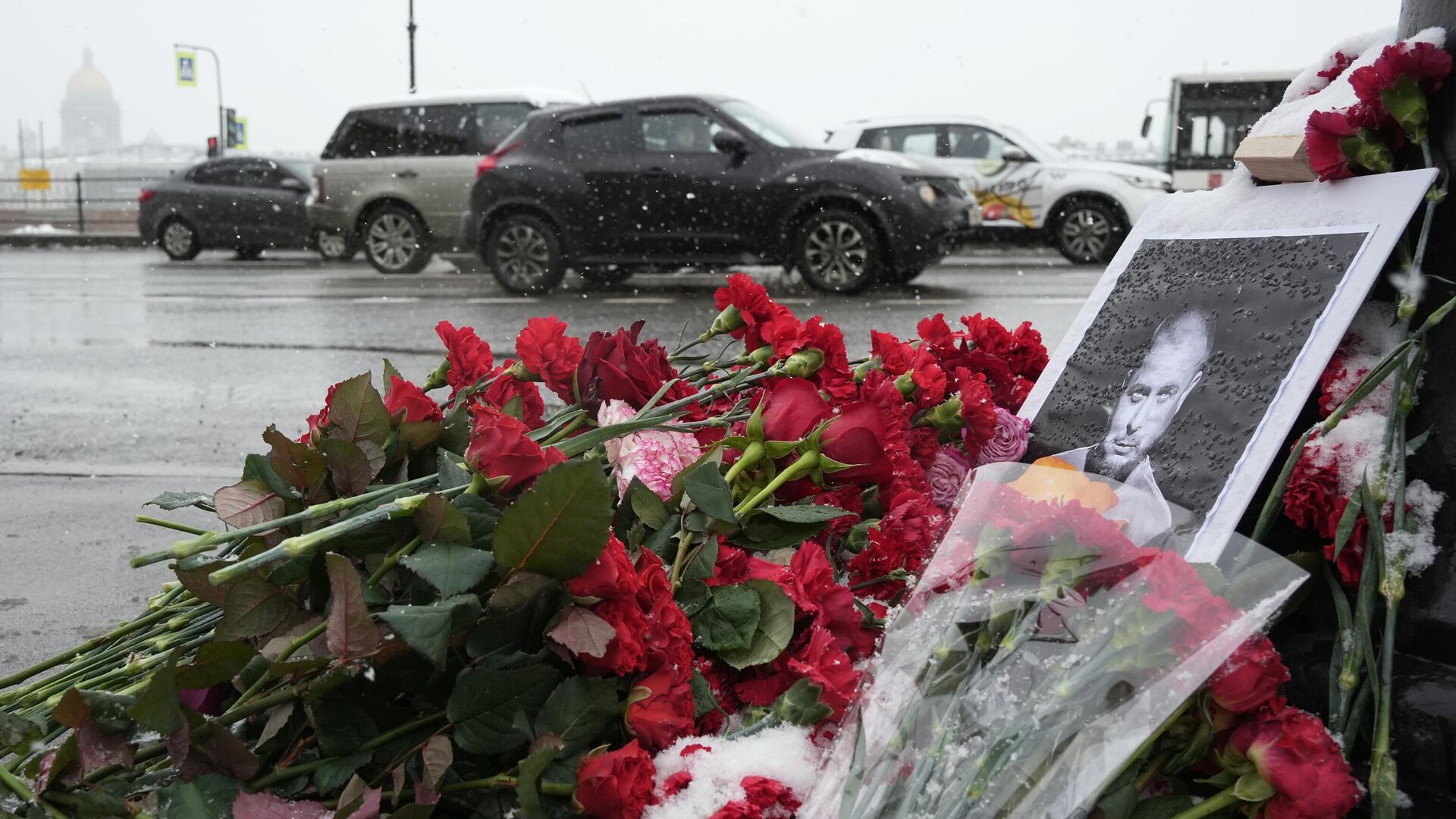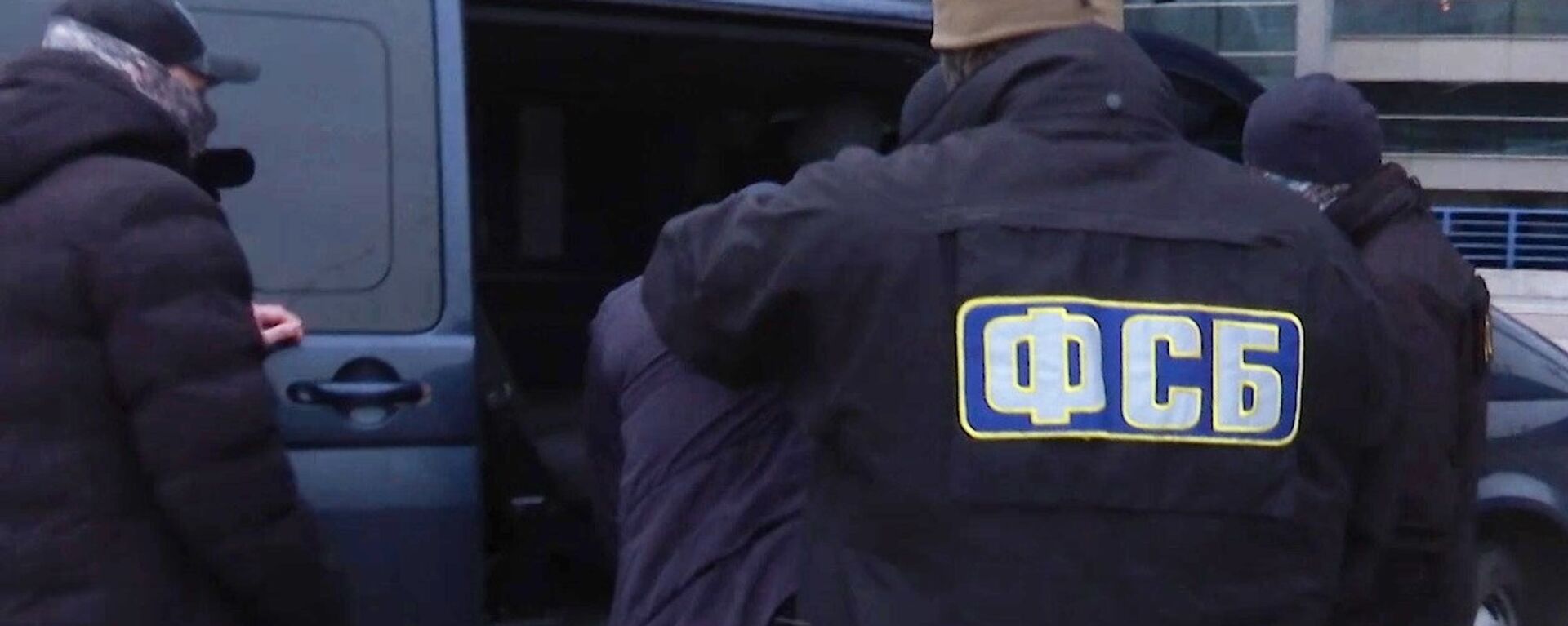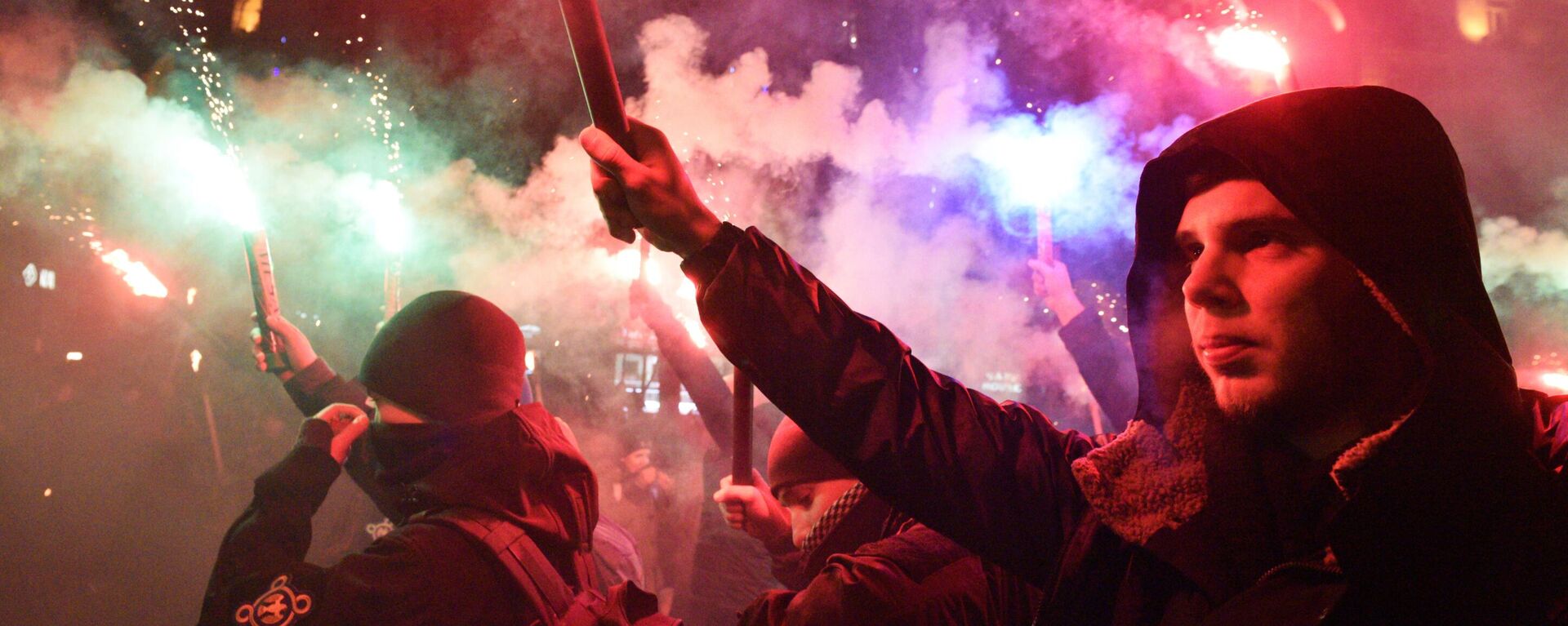https://sputnikglobe.com/20230403/targeting-the-unarmed-ukraines-grim-record-of-terrorist-attacks-1109074865.html
Targeting the Unarmed: Ukraine's Grim Record of Terrorist Attacks
Targeting the Unarmed: Ukraine's Grim Record of Terrorist Attacks
Sputnik International
A look at the timeline of events, recent as well as hailing back to 2014, laying bare the bloodthirsty tactics employed by the Kiev regime.
2023-04-03T15:55+0000
2023-04-03T15:55+0000
2023-04-03T15:55+0000
russia
vladlen tatarsky's assassination
ukraine crisis
alexander dugin
crimean bridge
zaporozhye region
denis pushilin
alexander zakharchenko
https://cdn1.img.sputnikglobe.com/img/07e7/04/03/1109084628_0:27:3072:1755_1920x0_80_0_0_f27de2fb1a551fd0c08dddcf20d368a1.jpg
Russia's National Anti-Terrorism Committee announced on Monday that the April 2 attack that killed 40-year-old Donbass-born journalist and war correspondent Vladlen Tatarsky was masterminded by Ukraine's special services.Tatarsky, whose real name was Maxim Fomin, died in an explosion at a café in St. Petersburg. The Russian Investigative Committee has already detained a suspect in the blast - St. Petersburg native Daria Trepova, an "active supporter" of an extremist group.This latest brutal killing is testimony to the fact that Russia is forced to contend with a regime in Kiev that "supports terrorist actions, which is responsible for the murder of Daria Dugina. A regime which quite possibly is behind Fomin's murder, and behind the terrorist attack in St. Petersburg, which is responsible for the murder of people for many years, since 2014," Kremlin spokesman Dmitry Peskov underscored.Here is a look at the timeline of events, recent as well as hailing back to 2014, laying bare the bloodthirsty tactics employed by the Kiev regime.Bryansk Terror AttackPresident Putin characterized the Bryansk attack, carried out in early 2023 using NATO weapons, as a "terrorist attack" of a kind typically committed "by the neo-Nazis and their masters."The founder of Ukraine's right-wing Russian Volunteer Corps, Denis Kapustin, a Russian citizen living in Ukraine and acting on orders of the SBU, was behind the attack on Russia's Bryansk region on March 2, 2023, according to the Russian Federal Security Service (FSB). A sabotage group from Ukraine penetrated the border into the territory of the Klimovsky district's Lyubechane village, firing at a moving vehicle, killing two people and injuring a child. The Ukrainian nationalists were then forced back into the territory of Ukraine, where they were subjected to a massive artillery strike.According to the FSB, Denis Kapustin is also responsible for an assassination attempt on Konstantin Malofeev, chairman of the board of directors of the media group Tsargrad. The perpetrators sought to blow up the car carrying Malofeev, who is known for his active support of the Russian special operation in Ukraine and contribution to the delivery of humanitarian aid to the people of Donbass.A video, shared by the FSB, showed federal agents dismantling the bomb placed under his car and foiling the plot. Furthermore, the footage revealed how the FSB thwarted another Kapustin-masterminded terror attack - a scheme to blow up a Volgograd Region-based oil and gas facility in August 2022.Murder of Daria DuginaUkraine's special services were behind the murder of Russian conservative journalist Daria Dugina, daughter of political scientist Alexander Dugin, a former Moscow State University professor, who actively supported the liberation of Donbass and Russia's special operation in Ukraine. The 29-year-old journalist, who shared the same values as her father, was killed instantly on August 20, 2022, on a highway outside Moscow after a powerful car bomb attached to the SUV she was driving detonated. Presumably, Alexander Dugin was the one targeted by the terrorists, but he was not in the car at the moment of the explosion.The perpetrator of the crime was Natalya Vovk, a Ukrainian national born in 1979, the Federal Security Service concluded. Vovk was said to have rented an apartment in the same building where Dugina resided to glean details about her lifestyle. The perpetrator was said to have driven a vehicle that entered Russia with Donetsk People's Republic plates, used Kazakhstan plates while in Moscow, and Ukrainian plates when leaving the country through the Pskov region into Estonia.Bombing of Crimean BridgeNot only individuals have been targeted by the bloodthirsty Kiev authorities, but Russia's infrastructure as well. A case in point is the bombing of the Crimean Bridge carried out by Ukrainian intelligence services. It became yet another glaring example of how the regime holed up in Kiev was honed to perpetrate terrorist attacks on Russian soil.Crimea reunited with Russia in 2014 after a referendum in which over 96% of the peninsula's voters were in favor of the move. Russian President Vladimir Putin signed a decree on March 21 to ratify the reunification treaties with the Republic of Crimea and the city of Sevastopol. After the reunification, Russia began building a bridge to connect the peninsula with the mainland. The Crimean bridge is the longest in Europe (18,100 m), and boasts a four-lane road and a double-track railway, running in parallel, spanning the Kerch Strait. On October 8, 2022, the Kiev regime staged a blast on the Kerch Strait Bridge, killing multiple people and damaging the structure.Donbass in Line of FireUkrainian radicals started with terrorism back in 2014. Kiev's policy of "state terrorism" became increasingly manifest from the moment when Viktor Yanukovych, then the legitimate Ukrainian president, was ousted in a Washington-backed coup, and the Donbass crisis escalated into a full-blown Russia-Ukraine conflict. The putschist government that seized power in Kiev unleashed a war against its own people in the spring of 2014, when residents of the Donetsk and Lugansk regions declared independence from Kiev's US- and EU- installed pawns, the Ukrainian authorities engaged in ever-increasing humiliation of the predominantly Russian-speaking people in Donbass, all the while openly supporting Nazi ideas.Neither President Petro Poroshenko nor Volodymyr Zelensky implemented treaty obligations under the Minsk accords, brokered by the Normandy Four: Germany, Russia, France, and Ukraine. Kiev persistently sabotaged the Minsk accords, resorted to militarization, and constantly subjected the peaceful residents of the Donetsk and Lugansk People's Republics to heavy shelling. Moscow has repeatedly offered indisputable proof that what the population of Donbass had to endure throughout the eight years of conflict was nothing short of genocide of its civilian population. Donbass officials were immediately in the crosshairs of the Kiev warmongers.On August 31, 2018, Alexander Zakharchenko, at the time the head of the self-proclaimed Donetsk People's Republic (DPR), was killed in a blast at a café in central Donetsk. 11 other people were injured. The DPR authorities declared the incident a terrorist attack.Zakharchenko's assassination was committed with the assistance of Western intelligence services, the republic's then-acting head, Denis Pushilin, noted."The terrorist act was committed with the participation of the SBU Counterintelligence Fifth Department… As a result of the further work of DPR intelligence, analysis of the remnants of the explosive device revealed high technologies that were not previously used by the SBU, which makes it clear that this terrorist attack was committed with the assistance of Western special services," Pushilin stated.Moscow was forced to wade in on February 24, 2022, launching a special military operation in Ukraine amid warning signs that Kiev was gearing up for a new attempt to crush the fledgling Donbass republics by force. In response, Washington, NATO, and their European allies unleashed a barrage of sanctions targeting Moscow. At the same time, they began pumping Ukraine with weaponry to prop up the regime in Kiev.Attacks on Local OfficialsFollowing the terrorist attack on the Crimean Bridge, Russia embarked on a campaign of precision strikes on infrastructure facilities across Ukraine, as Moscow proceeded with its military operation to "de-Nazify and demilitarize" the country.The republics of Lugansk and Donetsk, as well as the regions of Kherson and Zaporozhye, were incorporated into Russia in October 2022 in the wake of referendums held earlier that year. The Russian president explained that Moscow sought to shield the roughly five million civilians of Donbass, Kherson, and Zaporozhye from atrocities, terror attacks, and indiscriminate shelling conducted by the Ukrainian military and neo-Nazi forces. However, the Donbass republics and the new Russian territories immediately found themselves under attack by the Kiev regime, which had been training sabotage groups and recruiting pro-Ukrainian residents. Kiev sought to glean information on the movement of Russian troops, damage transport infrastructure, and assassinate pro-Russian officials. In July 2022, Ukrainian authorities made an attempt on the life of the head of the Melitopol district of the Zaporozhye region Andrey Siguta. He was not injured, and continues to carry out his duties. A saboteur fired at the house of the official, after which he tried to hide in a wooded area in the suburbs of Melitopol. During his arrest, the attacker put up an armed resistance and was shot dead. The incident was classified as a terrorist attack.Vladimir Saldo, the head of the military-civilian administration of the Kherson region, managed to escape an assassination attempt thanks to the actions of vigilant residents. An improvised explosive device planted along the route of the car of the head of the Kherson Regional State Administration was detected in time and neutralized by Russian sappers. Vitaly Bulyuk, first deputy head of the Kherson regional administration, was injured in an assassination attempt on when his car blew up, killing one civilian.Other officials, alas, have fallen to the bloody Kiev regime. Thus, the head of the Family, Youth, and Sports Department of the Kherson administration, Dmitry Savluchenko, died when his car was blown up.In November 2022, Donetsk People’s Republic (DPR) Supreme Court Judge Alexander Nikulin suffered gunshot wounds in an assassination attempt in the city of Uglegorsk. According to DPR head Denis Pushilin, the judge had "sentenced Nazi criminals." Indeed, in 2022, Nikulin presided over the trial of captured Ukrainian soldiers and foreign mercenaries who surrendered following the siege of Mariupol and Azovstal plant. Mariupol came under Russian control on April 21, 2022, and the remaining Azov-affiliated Ukrainian radicals sheltered at Azovstal. Russia offered safe exit to all those who agreed to surrender and lay down arms. The gradual exodus from Azovstal ended on May 20, when a total of 2,400 Ukrainian militants surrendered and the plant fell under the control of Russian forces.
https://sputnikglobe.com/20230403/terror-attack-against-vladlen-tatarsky-was-plotted-by-ukrainian-special-services-moscow-says-1109070642.html
https://sputnikglobe.com/20230306/fsb-ukraines-russian-volunteer-corps-founder-behind-attack-on-bryansk-region-1108080390.html
https://sputnikglobe.com/20220822/russias-fsb-ukrainian-special-services-behind-murder-of-daria-dugina-1099854294.html
https://sputnikglobe.com/20221010/crimean-bridge-attack-ukraines-sabotage-teams-take-orders-from-washington-senior-official-reveals-1101698419.html
https://sputnikglobe.com/20220416/genocide-of-donbass-civilian-population-evidence-from-the-lens-of-photojournalist-valery-melnikov--1094807994.html
https://sputnikglobe.com/20180915/ukraine-dpr-zakharchenko-arrest-1068056002.html
https://sputnikglobe.com/20220422/russian-mod-moscow-ready-to-announce-ceasefire-at-any-moment-to-evacuate-civilians-from-azovstal--1094965439.html
https://sputnikglobe.com/20220411/neo-nazism-in-ukraine-ultranationalists-on-the-march-1094616537.html
zaporozhye region
Sputnik International
feedback@sputniknews.com
+74956456601
MIA „Rossiya Segodnya“
2023
News
en_EN
Sputnik International
feedback@sputniknews.com
+74956456601
MIA „Rossiya Segodnya“
Sputnik International
feedback@sputniknews.com
+74956456601
MIA „Rossiya Segodnya“
ukrainian terror attacks against russia, kiev regime, murder of vladlen tatarsky, a military blogger and front line correspondent, assassination plot, targeting civilians, donbass atrocities, murder of daria dugina, washington-backed coup in 2014, donbass crisis ,russia's special military operation in ukraine, donbass genocide, alexander zakharchenko's assassination, bombing of crimean bridge, donbass, kherson and zaporozhye regions, referendums on joining russia, training sabotage groups and recruiting pro-ukrainian residents,
ukrainian terror attacks against russia, kiev regime, murder of vladlen tatarsky, a military blogger and front line correspondent, assassination plot, targeting civilians, donbass atrocities, murder of daria dugina, washington-backed coup in 2014, donbass crisis ,russia's special military operation in ukraine, donbass genocide, alexander zakharchenko's assassination, bombing of crimean bridge, donbass, kherson and zaporozhye regions, referendums on joining russia, training sabotage groups and recruiting pro-ukrainian residents,
Russia's National Anti-Terrorism Committee announced on Monday that the April 2
attack that killed 40-year-old Donbass-born journalist and war correspondent Vladlen Tatarsky was
masterminded by Ukraine's special services.
Tatarsky, whose real name was Maxim Fomin, died in an explosion at a café in St. Petersburg. The Russian Investigative Committee has already detained a suspect in the blast - St. Petersburg native Daria Trepova, an "active supporter" of an extremist group.
This latest brutal killing is testimony to the fact that Russia is forced to contend with
a regime in Kiev that "
supports terrorist actions, which is responsible for the murder of Daria Dugina. A regime which quite possibly is behind Fomin's murder, and behind the terrorist attack in St. Petersburg, which is responsible for the murder of people for many years, since 2014," Kremlin spokesman Dmitry Peskov underscored.
Here is a look at the timeline of events, recent as well as hailing back to 2014, laying bare the bloodthirsty tactics employed by the Kiev regime.
President Putin characterized
the Bryansk attack, carried out in early 2023 using NATO weapons, as a "
terrorist attack" of a kind typically committed "
by the neo-Nazis and their masters."
The founder of Ukraine's right-wing Russian Volunteer Corps, Denis Kapustin, a Russian citizen living in Ukraine and acting on orders of the SBU, was behind the
attack on Russia's Bryansk region on March 2, 2023, according to the Russian Federal Security Service (FSB). A sabotage group from Ukraine penetrated the border into the territory of the Klimovsky district's Lyubechane village, firing at a moving vehicle, killing two people and
injuring a child. The Ukrainian nationalists were then forced back into the territory of Ukraine, where they were subjected to a massive artillery strike.
According to the FSB, Denis Kapustin is also responsible for an assassination attempt on Konstantin Malofeev, chairman of the board of directors of the media group Tsargrad. The perpetrators sought to blow up the car carrying Malofeev, who is known for his active support of the Russian special operation in Ukraine and contribution to the delivery of humanitarian aid to the people of Donbass.
A video, shared by the FSB, showed federal agents dismantling the bomb placed under his car and foiling the plot. Furthermore, the footage revealed how the FSB thwarted another Kapustin-masterminded terror attack - a scheme to blow up a Volgograd Region-based oil and gas facility in August 2022.
Ukraine's special services were behind the murder of
Russian conservative journalist Daria Dugina, daughter of political scientist Alexander Dugin, a former Moscow State University professor, who actively supported the liberation of Donbass and Russia's special operation in Ukraine. The 29-year-old journalist, who shared the same values as her father,
was killed instantly on August 20, 2022, on a highway outside Moscow after a powerful car bomb attached to the SUV she was driving detonated. Presumably, Alexander Dugin was the one targeted by the terrorists, but he was not in the car at the moment of the explosion.
The perpetrator of the crime was Natalya Vovk, a Ukrainian national born in 1979, the Federal Security Service concluded. Vovk was said to have rented an apartment in the same building where Dugina resided to glean details about her lifestyle. The perpetrator was said to have driven a vehicle that entered Russia with Donetsk People's Republic plates, used Kazakhstan plates while in Moscow, and Ukrainian plates when leaving the country through the Pskov region into Estonia.
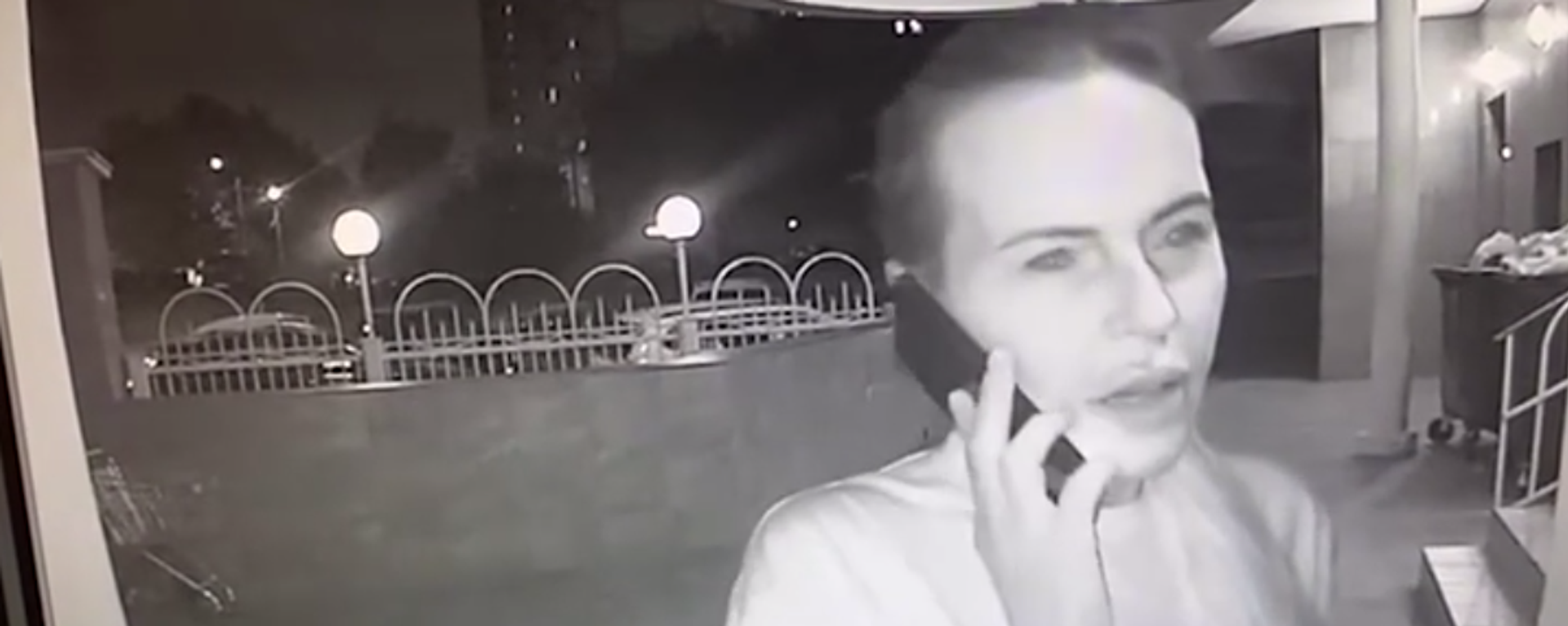
22 August 2022, 11:11 GMT
Bombing of Crimean Bridge
Not only individuals have been targeted by the bloodthirsty Kiev authorities, but Russia's infrastructure as well. A case in point is the bombing of the Crimean Bridge carried out by Ukrainian intelligence services. It became yet another glaring example of how the regime holed up in Kiev was honed to perpetrate terrorist attacks on Russian soil.
Crimea reunited with Russia in 2014 after a referendum in which over 96% of the peninsula's voters were in favor of the move. Russian President Vladimir Putin signed a decree on March 21 to ratify the reunification treaties with the Republic of Crimea and the city of Sevastopol. After the reunification, Russia began building a bridge to connect the peninsula with the mainland. The Crimean bridge is the longest in Europe (18,100 m), and boasts a four-lane road and a double-track railway, running in parallel, spanning the Kerch Strait. On October 8, 2022, the Kiev regime
staged a blast on the Kerch Strait Bridge, killing multiple people and damaging the structure.
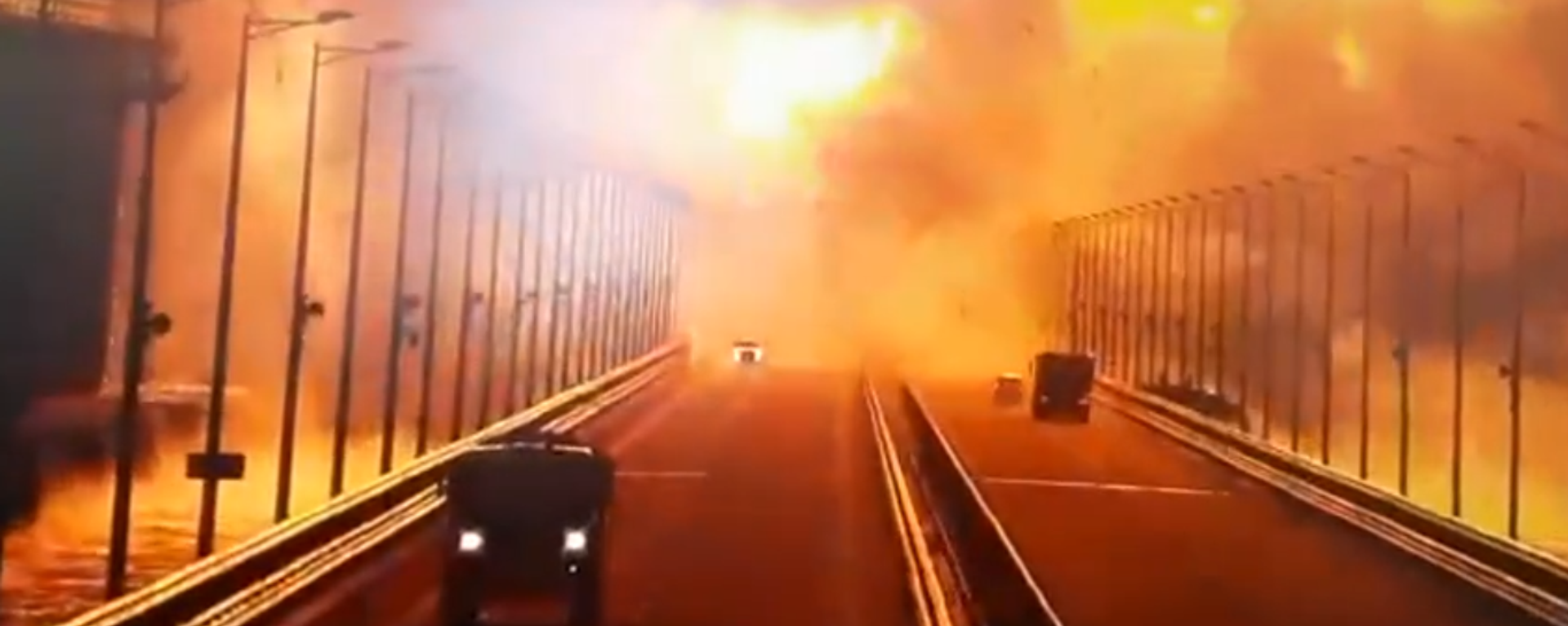
10 October 2022, 18:23 GMT
Ukrainian radicals started with terrorism back in 2014.
Kiev's policy of "state terrorism" became increasingly manifest from the moment when Viktor Yanukovych, then the legitimate Ukrainian president, was ousted in a
Washington-backed coup, and the Donbass crisis escalated into a full-blown Russia-Ukraine conflict. The putschist government that seized power in Kiev unleashed
a war against its own people in the spring of 2014, when residents of the Donetsk and Lugansk regions declared independence from Kiev's US- and EU- installed pawns, the Ukrainian authorities engaged in ever-increasing humiliation of the predominantly Russian-speaking people in Donbass, all the while openly
supporting Nazi ideas.
Neither President Petro Poroshenko nor Volodymyr Zelensky implemented treaty obligations under the
Minsk accords, brokered by the Normandy Four: Germany, Russia, France, and Ukraine. Kiev persistently sabotaged the Minsk accords, resorted to militarization, and constantly subjected the peaceful residents of the Donetsk and Lugansk People's Republics to heavy shelling. Moscow has repeatedly offered indisputable proof that what the population of Donbass had to endure throughout the eight years of conflict was nothing short of
genocide of its civilian population.
Donbass officials were immediately in the crosshairs of the Kiev warmongers.
On August 31, 2018,
Alexander Zakharchenko, at the time the head of the self-proclaimed Donetsk People's Republic (DPR), was killed in a blast at a café in central Donetsk. 11 other people were injured. The DPR authorities declared the incident a
terrorist attack.
Zakharchenko's assassination was committed with the assistance of Western intelligence services, the republic's then-acting head, Denis Pushilin, noted.
"The terrorist act was committed with the participation of the SBU Counterintelligence Fifth Department… As a result of the further work of DPR intelligence, analysis of the remnants of the explosive device revealed high technologies that were not previously used by the SBU, which makes it clear that this terrorist attack was committed with the assistance of Western special services," Pushilin stated.
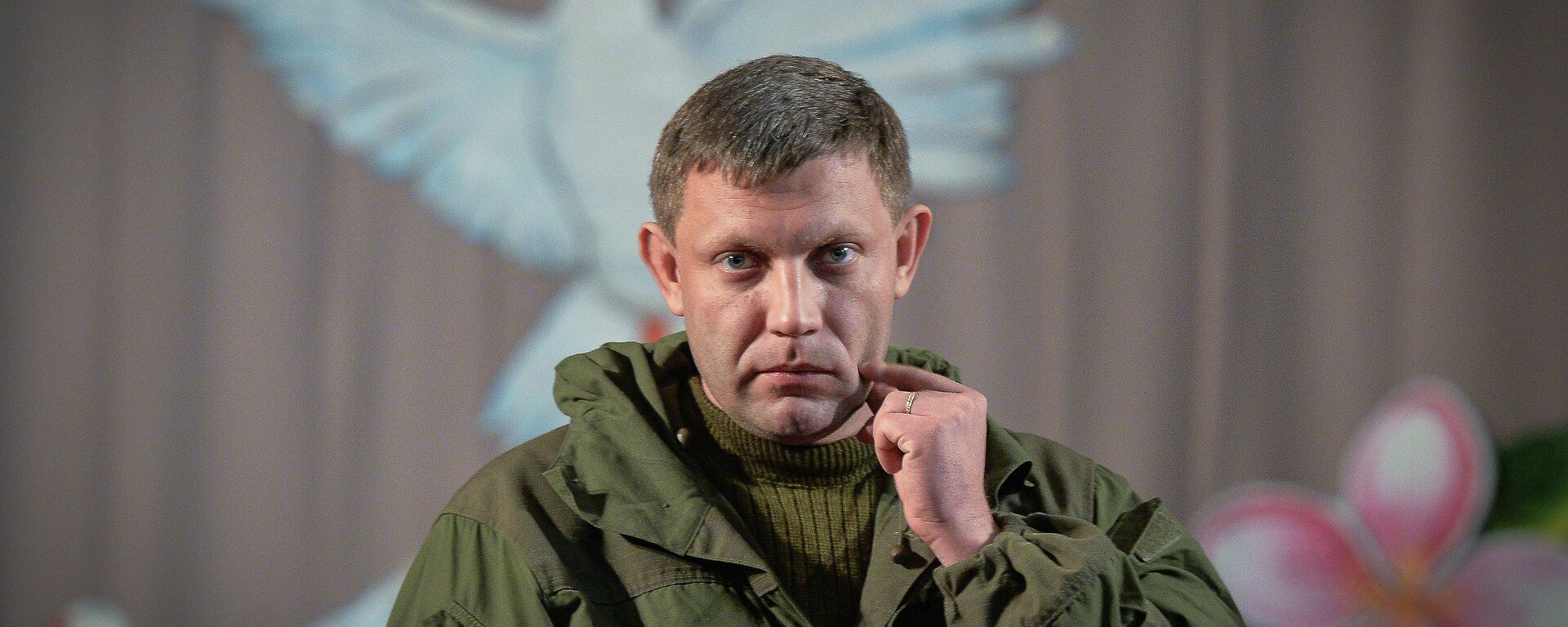
15 September 2018, 07:38 GMT
Moscow was forced to wade in on February 24, 2022, launching
a special military operation in Ukraine amid warning signs that Kiev was gearing up for a new attempt to crush the fledgling Donbass republics by force. In response, Washington, NATO, and their European allies unleashed a barrage of
sanctions targeting Moscow. At the same time, they began pumping Ukraine
with weaponry to prop up the regime in Kiev.
Attacks on Local Officials
Following the terrorist attack on the Crimean Bridge, Russia embarked on a campaign of precision strikes on infrastructure facilities across Ukraine, as Moscow proceeded with its military operation to "de-Nazify and demilitarize" the country.
The republics of Lugansk and Donetsk, as well as the
regions of Kherson and Zaporozhye, were incorporated into Russia in October 2022 in the wake of referendums held earlier that year. The Russian president explained that Moscow sought to shield the roughly five million civilians of Donbass, Kherson, and Zaporozhye from atrocities, terror attacks, and indiscriminate shelling conducted by the Ukrainian military and neo-Nazi forces.
"We cannot, we have no moral right to let our kin and kith be torn to pieces by butchers; we cannot but respond to their sincere striving to decide their destiny on their own," Putin stated.
However, the Donbass republics and the new Russian territories immediately found themselves under attack by the Kiev regime, which had been training sabotage groups and recruiting pro-Ukrainian residents. Kiev sought to glean information on the movement of Russian troops, damage transport infrastructure, and assassinate pro-Russian officials.
In July 2022, Ukrainian authorities made an attempt on the life of the head of the Melitopol district of the
Zaporozhye region Andrey Siguta. He was not injured, and continues to carry out his duties. A saboteur fired at the house of the official, after which he tried to hide in a wooded area in the suburbs of Melitopol. During his arrest, the attacker put up an armed resistance and was shot dead. The incident was classified as a terrorist attack.
Vladimir Saldo, the head of the military-civilian administration of the Kherson region, managed to escape an assassination attempt thanks to the actions of vigilant residents. An improvised explosive device planted along the route of the car of the head of the Kherson Regional State Administration was detected in time and neutralized by Russian sappers. Vitaly Bulyuk, first deputy head of the Kherson regional administration, was injured in an assassination attempt on when his car blew up, killing one civilian.
Other officials, alas, have fallen to the bloody Kiev regime. Thus, the head of the Family, Youth, and Sports Department of the Kherson administration, Dmitry Savluchenko, died when his car was blown up.
In November 2022, Donetsk People’s Republic (DPR) Supreme Court Judge
Alexander Nikulin suffered gunshot wounds in an assassination attempt in the city of Uglegorsk. According to DPR head Denis Pushilin, the judge had "
sentenced Nazi criminals." Indeed, in 2022, Nikulin presided over the trial of captured Ukrainian soldiers and
foreign mercenaries who surrendered following the siege of Mariupol and Azovstal plant. Mariupol came under Russian control on April 21, 2022, and the remaining Azov-affiliated
Ukrainian radicals sheltered at Azovstal. Russia offered safe exit to all those who agreed to surrender and lay down arms. The gradual exodus from Azovstal ended on May 20, when a total of 2,400 Ukrainian militants surrendered and the plant fell under the control of Russian forces.
